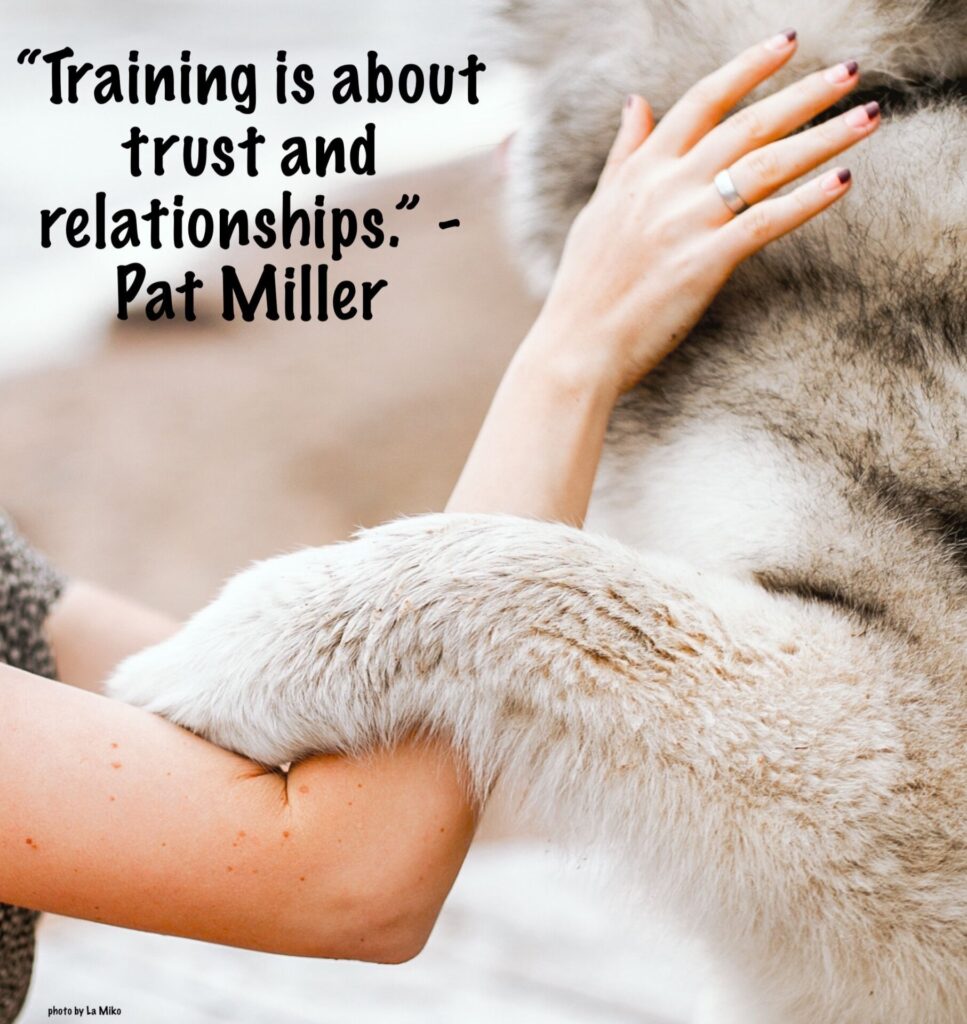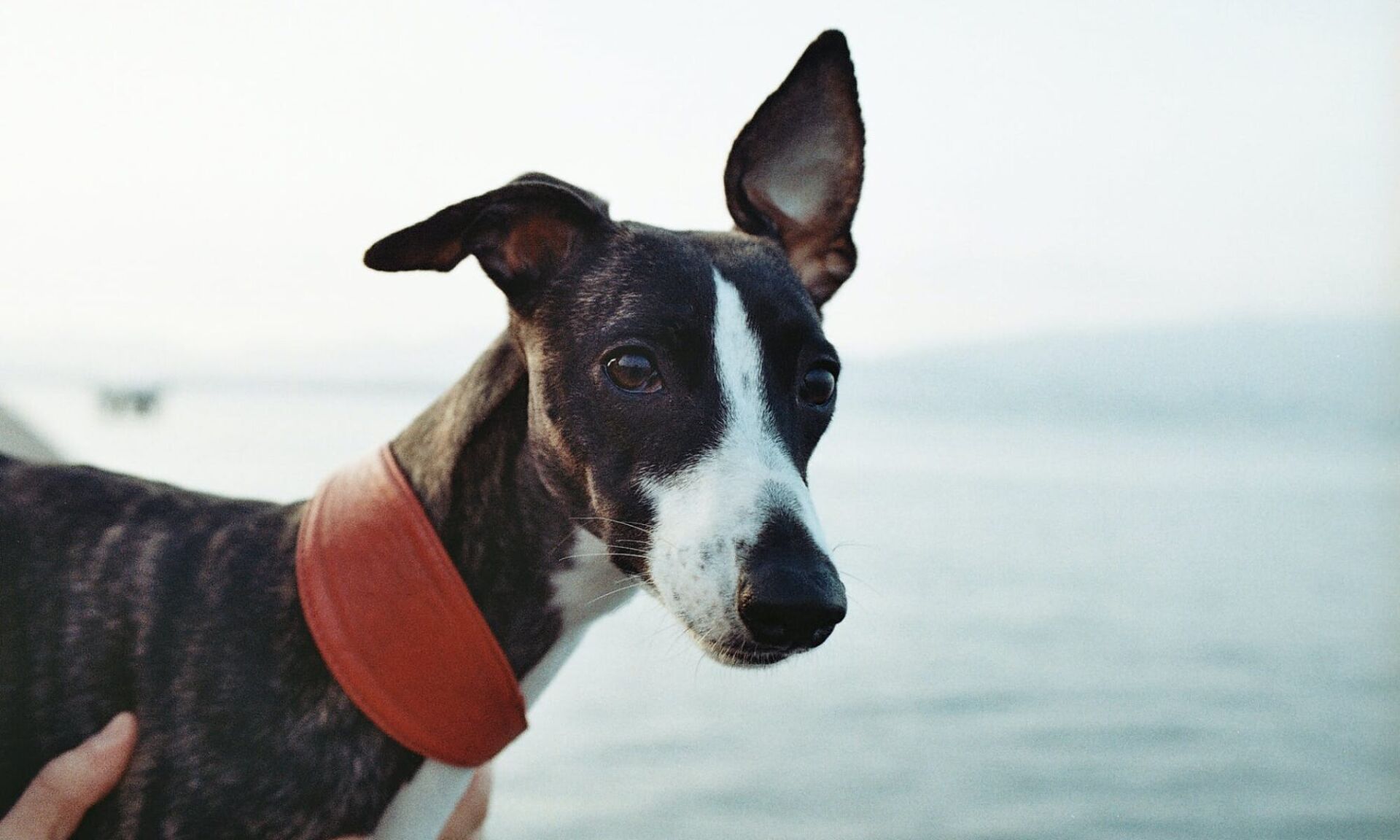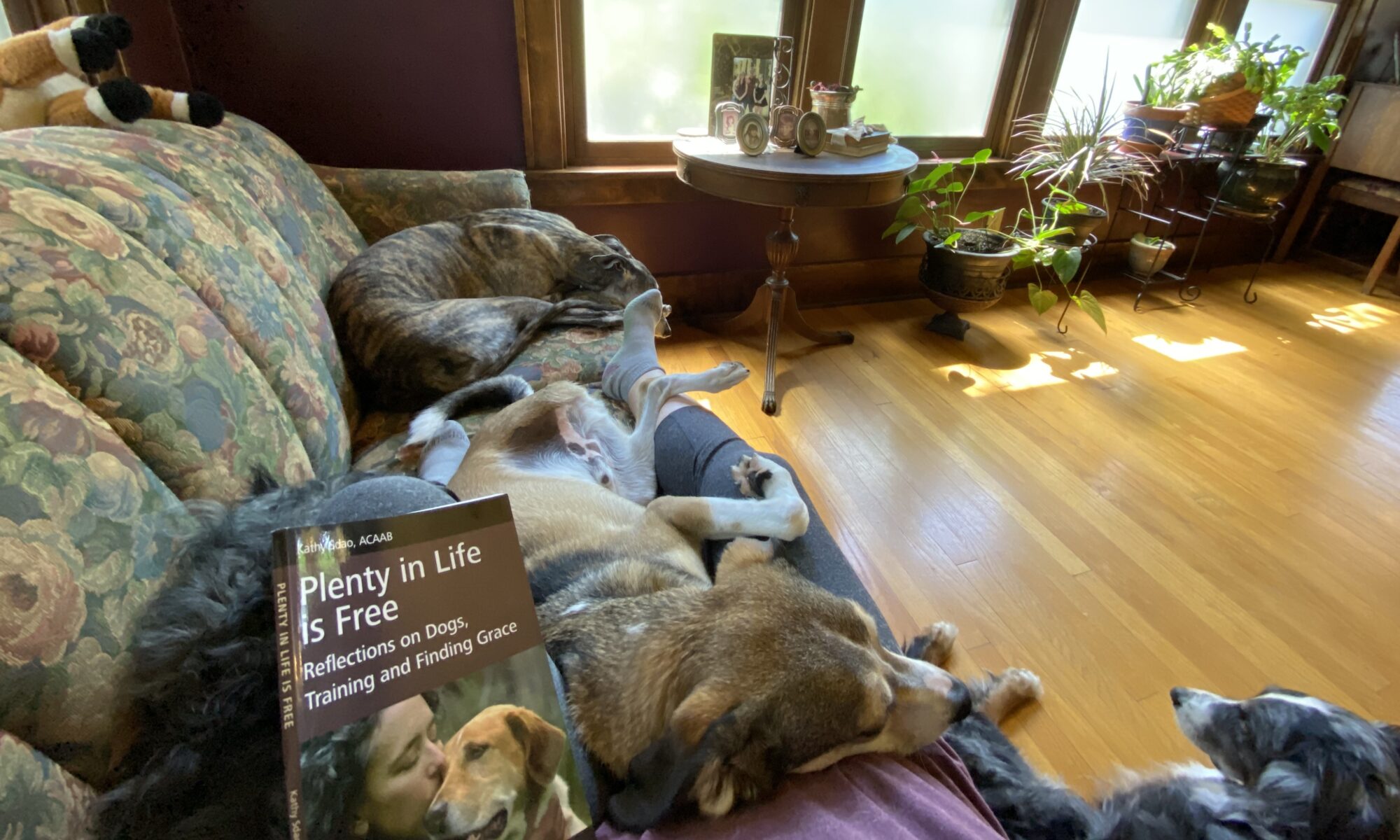During 2020, the number of people bringing a new pet into their homes skyrocketed. So much so, that Rescue Animals became TIME magazine’s Pet of the Year for 2020. Now that the new shine has worn off, many owners are looking for training resources for their dogs and often turn to self-help dog training manuals. Unfortunately, there are SO many such manuals out there that too many owners end up purchasing books that give outdated and inaccurate advice … often leading to abuse rather than training. So, how do you choose the right dog training manual?
As a certified professional dog trainer (CPDT-KA), my first advice any new dog owner is to find a certified dog trainer in their area. Dog training manuals are good resources, but nothing beats working directly with a professional. So, how do you find a good trainer? That is a whole blog post in itself, so I will direct you to this article on “How to Choose a Dog Trainer.”
So, now you have hired a professional and you want to buy a good dog training manual. With so many on the market, dog owners are flooded with options. But, how do you choose a dog training manual that will give you reliable and accurate information?
Most important, look for a book written by an expert in the field. I recently reviewed a dog training manual, Enlightened Dog Training: Become the Peaceful Alpha your Dog Needs and Respects, that was written by Jesse Sternberg, a mindfulness teacher, meditation instructor, and master dog trainer who has been working with animals for more than 30 years.
Sounds great, right?
Unfortunately, the dog training industry is not regulated, so anyone can proclaim themselves a “master dog trainer” and anyone who has had any contact with animals can say that they have “worked with animals for more than 30 years”. In fact, there is no indication that the author of this book has any type of dog training certification. Don’t let buzz words like “master dog trainer”, “dog whisperer” or “celebrity dog trainer” fool you! Remember that anyone can get themselves a social media account and start posting so-called dog training videos.
Beware of secret methods and techniques. No training method is “fool proof” or “guaranteed”. “Balanced” trainers may use treats, but also rely on punishment to turn your “disobedient” dog into a “respectful” and “obedient” dog. In contrast, look for trainers who are certified and/or have a degree in the field and use “positive reinforcement”, “LIMA”, “force free” or “fear free” methods. Visit their website or social media accounts to learn about their training philosophy and seeing videos of them training dogs.
In this blog, I have used quotes from Enlightened Dog Training as examples to demonstrate what you do NOT want from a dog training manual. Each quote is dissected for inaccuracies and poor dog training advice and is followed up with examples of excellent dog training manuals for the topic at hand.
“By mimicking the body language of an alpha dog as they seize assets or guard territory, we can counter-condition our dog’s excitement to any power object both quickly and calmly by leveraging a very simple law in the animal kingdom: the top dog always eats first, claims the asset with ease, and chooses the best resting spot with grace.”
“When a wolf hunt comes to an end, no pack member dares to show excitement around the spoils, nor do they even think about eating before the alpha male and female of the pack.”
In 1970, wolf expert David Mech introduced the world to the concept of “alpha” and “dominance” in his book, The Wolf: Ecology and Behavior of an Endangered Species. In fact, he recanted his original theory in 1999. He even states on his website that this book is “currently still in print, despite my numerous pleas to the publisher to stop publishing it.”
So, you can rest assured that your dog is not trying to exert his “dominance” over you or trying to be the “alpha.” And he certainly does not need you to be his “pack leader” – since the current science on dog behavior tells us that dogs are not even pack animals! Further, to continue to perpetuate this ideology, which has resulted in the abuse of countless dogs at the hands of owners who unknowingly think that they are doing the right thing, is absolutely unethical.
“From the moment we bring a dog into our home, they expect us to behave like an alpha.”
TRANSLATION: Don’t allow your dog to feel safe in your home.
A BETTER WAY: Ultimately, the most basic need for every being is to feel safe.
Dog Training Manuals to Choose

Don’t Shoot the Dog! The New Art of Teaching and Training
by Karen Pryor
Karen Pryor started her career working with marine mammals. Additionally, she is the founder of clicker training and the Karen Pryor Academy.
“One reason punishment doesn’t usually work is that it does not coincide with the undesirable behavior; it occurs afterward, and sometimes, as in courts of law, long afterward. The subject therefore may not connect the punishment to his or her previous deeds; animals never do, and people often fail to.” – Karen Pryor
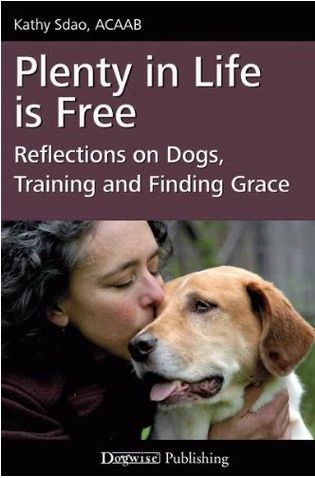
Plenty in Life is Free – Reflections on Dogs, Training and Finding Grace
by Kathy Sdao
Kathy Sdao is an applied animal behaviorist (ACAAB) and professional dog trainer.
“We humans repeatedly fall into the trap of thinking that power and control are what successful relationships are about. On deeper reflection, we can see that in our best relationships we communicate clearly and easily … In the long run, communication trumps control.” – Kathy Sdao
“Take 10 conscious breaths. Slowly leash your dog, and tether them to something in front of them. Form a lasso with the second leash, placing it around your dog’s hindquarters, and fasten it to another fixture behind them. This gentle restraint will keep your furry guru standing still and safe. Now it’s time to begin the working meditation of grooming your dog with love.”
TRANSLATION: Securely restrain your dog so that she cannot move away when you advance on her with scary tools.
A BETTER WAY: Teach your dog that grooming is safe and fun – and she is free to opt out at any time.
Dog Training Manuals to Choose
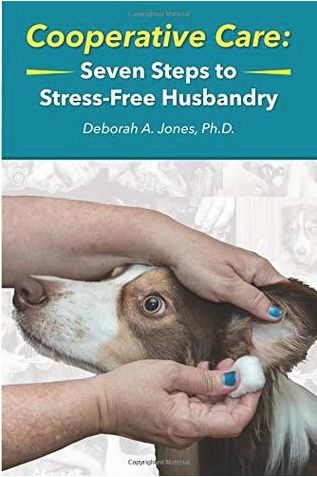
Cooperative Care: Seven Steps to Stress-Free Husbandry
by Deborah A Jones, Ph.D.
Deb Jones has a PhD in Psychology and is a legend in the dog training world. In fact, she also runs a fantastic Facebook group on the topic called “Cooperative Care with Deb Jones”.
“Be the turtle.” – Deb Jones.
(… meaning slow and steady wins the race)
“The suddenness of my assertive touch sobered her. Instinctively, she knew it was time to surrender, because making contact on the nape of a dog’s neck is a familiar connection point communicating status and authority.”
“Instinctively, I placed what I call my “Kung Fu Finger” gently on the scruff of his neck. When we touch our dogs on the nape of the neck, we remind them that we are the authority. This is where their mother picked them up when they were young and where aggressive dogs target their attacks.”
PLEASE NOTE: Under no circumstances are you a dog – nor are you your dog’s mother. Rather, this is not you communicating your status and authority. In truth, this is simply you using body language signals to communicate aggression and instill fear in your dog.
“After your dog retreats as a result of your intensified, fear-generating actions, place the bowl on the floor between your feet. This is known as the Asset Ownership position.”
TRANSLATION: This is you, behaving aggressively towards your dog.
ANALOGY: You arrive at your favorite restaurant and order your favorite dish. The waiter brings your meal and proceeds to set it on the table and stand over you, arms crossed and staring menacingly down at you. He continues to hold this stance, never speaking until you back away from the table. Only then, does he step back and say “Enjoy your meal.” Does this sound like the behavior of a sane individual?? Would you ever go back to that restaurant?
“Trust the process. Be patient, and remain in the asset-guarding position because the fun part of the training session has only just begun. Now that you have established ownership over the object your dog desires, they will not attempt to snatch it unless you lose focus and become distracted. Observe your dog over the next 10 minutes or so as its attention becomes single pointed on the hot dog (the object of their meditation). Notice as your dog progresses through increasingly relaxed positions, organically searching for stillness in their body.”
TRANSLATION: Stand over your dog’s bowl and continue to intimidate and bully your dog with your aggressive stance and delight in his efforts to use appeasement gestures to beg you to stop aggressing towards him. Can you imagine how a dog must feel after 10 minutes of this treatment?!?
NOTE: If your dog is looking away, panting, lifting a paw, laying down, crouching or rolling over, it can generally be translated as a dog that is worried, confused or scared.
Check out my blog on canine body language or you can sign up for my Canine Body Language for Pet Parents webinar for only $12!
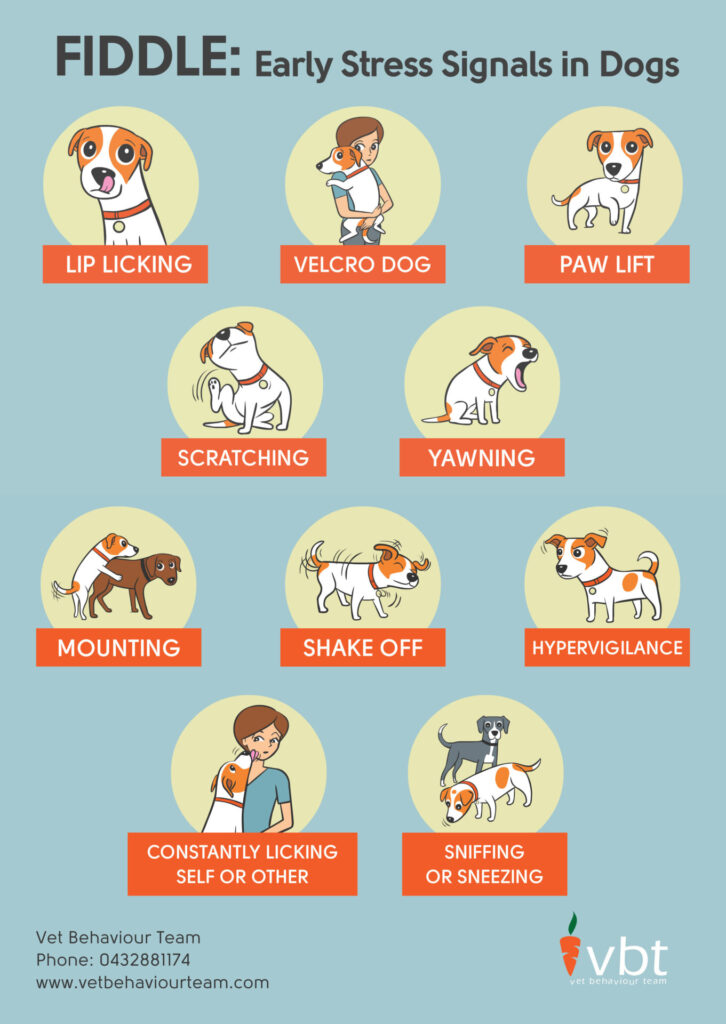
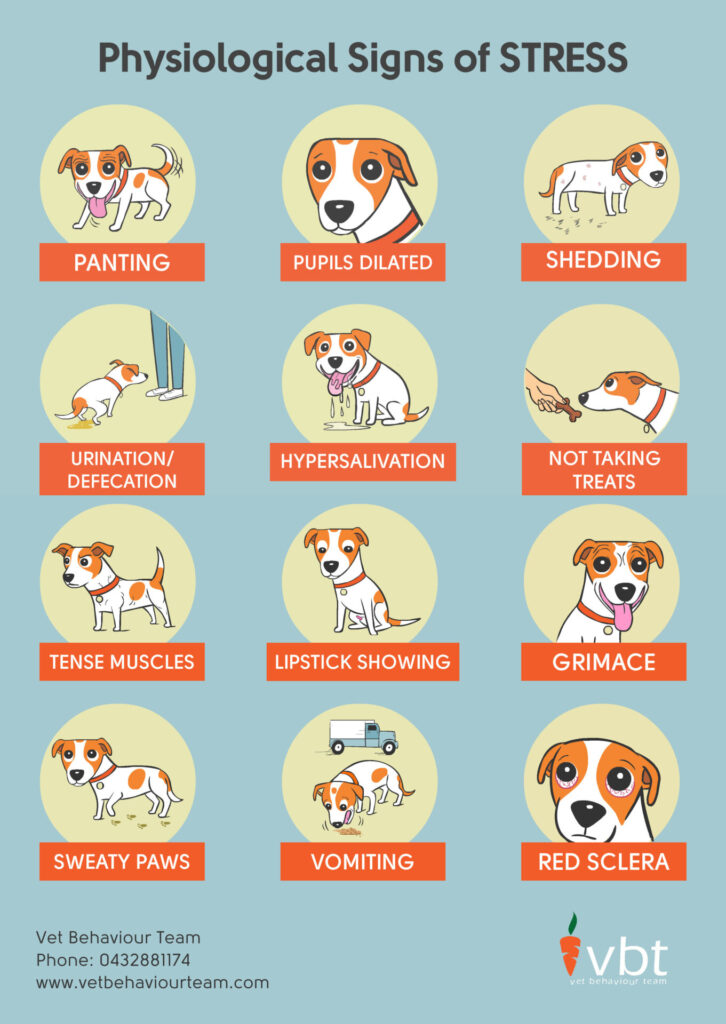
Dog Training Manuals to Choose
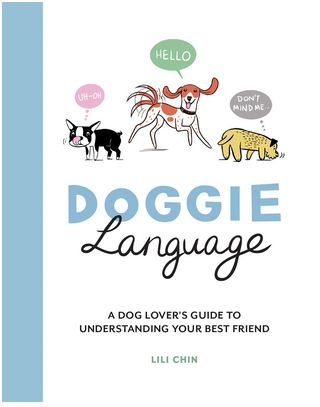
Doggie Language: A Dog Lover’s Guide to Understanding your Best Friend
by Lily Chin
Lili Chin creates educational artwork for veterinarians and dog trainers. This little book is an excellent reference on how to interpret your dog’s body language
She recently published a followup called Kittie Language.
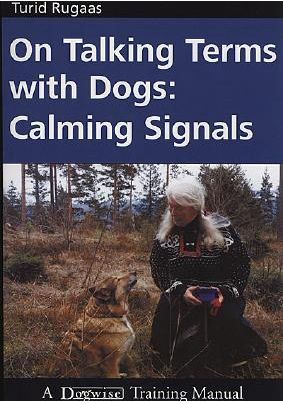
On Talking Terms with Dogs: Calming Signals
by Turid Rugaas
Turid Rugaas is a dog trainer and behaviorist in Norway. She is world-renowned for her work with calming signals in dogs – body language that dogs use to help calm themselves and others in stressful situations.
“We need to learn to understand the language of dogs so that we can understand what our dogs are telling us. That is the secret of having a good life together.” – Turid Rugaas

Listen to Me! Exploring the Emotional Life of Dogs
by Tricia Hollingshead
Tricia Hollingshead is a dog behaviorist who operates a home dog boarding and rehabilitation business,
“An eagle can swoop down and catch prey when it least expects it, so be like the eagle, and catch your dog in the moment it makes an indoor potty. In this moment, snap your fingers or make a gently conflict-seeking sound, followed by direct eye contact. This action is the “bad cop” moment, and the forbidden angle clearly communicates “no.” Don’t feel sad or think your puppy will get mad at you. Remember, fear is a normal emotion and animals don’t relate to it like we do.”
TRANSLATION: Take a puppy who has been on this earth for all of 8 to 10 weeks and set him up for failure. Wait for him to have an accident in your house and then swoop in to scare the living daylights out of him. Is this the stance that anyone would choose to use when potty training their child?!?
Set your puppy up for success!! Take him out to potty every hour or two and reward him generously when he potties outside.
Dog Training Manuals to Choose

Puppy Socialization: What It Is and How To Do It
by Marge Rogers and Eileen Anderson
Marge Rogers is a certified dog trainer and behavior consultant and Eileen Anderson is an award-winning writer who shares excellent, science-based information with dog owners through her blog, Eileen and Dogs
The authors also created a complimentary website called The Puppy Socialization Project.
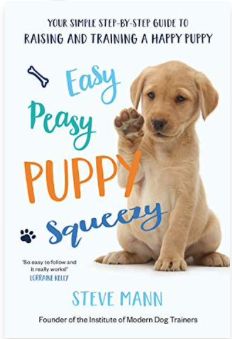
Easy Peasy, Puppy Squeasy: Raising and Training a Happy Puppy
by Steve Mann
Steve Mann is a professional trainer and behaviorist.
“If you have a dog that likes hanging out with you, 90% of your problems are gone.” – Steve Mann on developing the Rucksack Walk

How to Raise a Puppy: A Dog-centric Approach
by Stephanie Rousseau and Turid Rugaas
Stephanie Rousseau is a dog behaviorist based in Ireland and Turid Rugaas is a dog trainer and behaviorist in Norway. Together they created an excellent guide to raising a puppy.
“Puppies chew things to explore, learn, and soothe the pain of teething. How we act in these moments shapes their future behavior. Screaming or showing excitement, for example, quickly turn the act of teething into an interactive game.”
Absolutely true … but here is where the author gets it really wrong
“On the other hand, acting assertively and using Alpha tactics to guard the moccasin like a resource (a power object) would effectively stop Rambo from chewing them. Asserting yourself in this fashion to such a young pup, however, makes you come across as unnecessarily scary. It’s not age-appropriate until about six months of age.”
TRANSLATION: Screaming and yelling like a distraught individual is inappropriate, but using fear and aggression stances is okay as soon as your puppy is 6 months old. Seriously, I can’t even …
Puppies and dogs chew, dig and bark – that, my friends, is the nature of a dog.
A BETTER WAY: Puppy-proof your home … just like you would baby-proof your home. Make sure your puppy has plenty of appropriate chew toys and encourage him to chew appropriately by using toys that can be filled with food or treats.
Dog Training Manuals to Choose
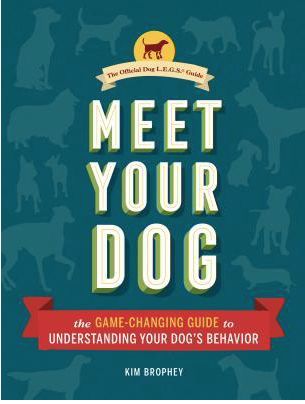
Meet Your Dog: The Game-Changing Guide to Understanding your Dog’s Behavior
by Kim Brophey
Kim Brophey is an applied ethologist and certified dog trainer and behaviorist. She developed the L.E.G.S. framework to help owners understand their dogs.
“Learning is not an event; it is a constant process, and it is your responsibility to foster experiences that will be beneficial to her perpetual learning.” – Kim Brophey

Canine Enrichment for the Real World: Making It a Part of your Dog’s Daily Life
by Allie Bender and Emily Strong
Allie Bender and Emily Strong are certified dog trainers and behavior consultants.
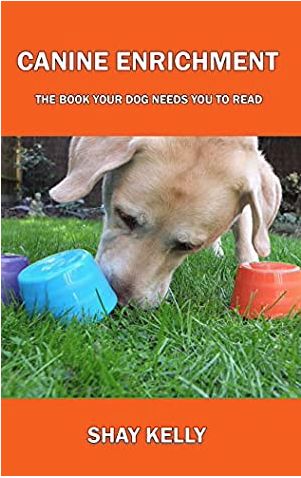
Canine Enrichment: The Book your Dog Needs You to Read
by Shay Kelly
Shay Kelly is a certified canine behavior consultant. His “Canine Enrichment” Facebook page is filled with excellent ideas.
“A recall should never signal the end of something interesting. It should signal the beginning of something fabulous” – Shay Kelly
“Alphas are conscientious commanders. We don’t ask our dogs to do things; we tell them to do things. They listen to us and serve us with joy, because our actions mean love in all forms.”
TRANSLATION: Dogs are furry little minions who were created solely for our pleasure and amusement.
A BETTER WAY: Dogs are sentient beings who have emotion. They feel fear, anger and pain. They are not here to simply do our bidding.
Dog Training Manuals to Choose
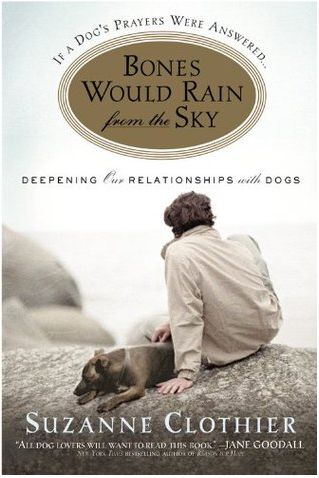
Bones Would Rain from the Sky: Deepening Our Relationships With Dogs
by Suzanne Clothier
Suzanne Clothier is a world class dog trainer, known for her ralationship-centered training methods.
One of the best books I have ever read about the bond between humans and dogs.
“One of the great pleasures of being with dogs is their spontaneous expression of what they are feeling” – Suzanne Clothier
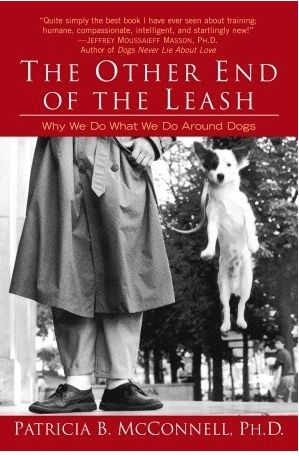
The Other End of the Leash: Why We Do What We Do Around Dogs
by Patricia McConnell, Ph.D.
Patricia McConnell has a Ph.D. in animal behavior and is a certified dog trainer and behavior consultant. Her blog, The Other End of the Leash, is filled with training advice and wonderful stories about her dogs.
“Positive reinforcement is always, by definition, decided by the receiver, not by the “giver’.” – Patricial McConnell
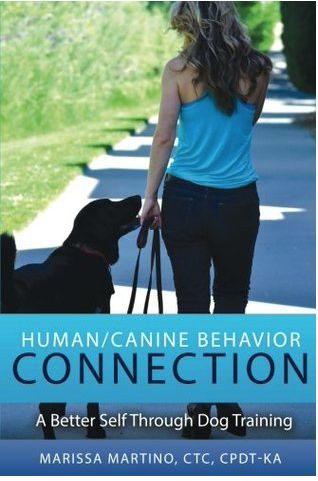
Human Canine Behavior Connections: A Better Self Through Dog Training
by Marissa Martino
Marissa Martino is a certified dog trainer and behavior consultant. Her “Paws and Reward” podcast is great source of information about how to foster a bond with your dog.

Wag: The Science of Making your Dog Happy
by Zazie Todd, Ph.D.
Zazie Todd has a Ph.D. in psychology and is a certified professional dog trainer. Check out Zazie Todd’s blog, Companion Animal Psychology.
“Don’t use punishment. It does not teach your dog what to do instead of the problem behavior and it interferes with the dog’s feelings of safety.” – Zazie Todd
“For example, when your dog snatches a dirty sock from your laundry for a game of tug, make your assertive noise, march toward them in a straight line, and watch as they drop the sock and offer you a Calming Signal.”
“Begin to imagine that you’re a lion, an animal no dog would dare challenge. Slowly stand up, and remain still; this is known as the Mountain Pose in yoga. Softly gaze at your dog, sending it the tiniest vibration of fear and inviting it for a challenge.”
TRANSLATION: The next time your dog grabs a sock and invites you to play, advance on him in aggressive posture to scare him into dropping the sock and cowering away from you.
A BETTER PLAN: Present a toy or treat to trade for the sock and then play with your dog.
NOTE: When your dog resists you taking something from him, he is simply engaging in what every other mammal (including humans) in the animal kingdom does – guarding a resource. While unwanted, it is perfectly natural behavior.
ANALOGY: Kerrie absolutely LOVES chocolate, but, alas, she is on a diet. After a week of eating only healthy stuff, she just sat down to enjoy a slice of chocolate cake. Her husband walks up, grabs her plate and starts eating her cake. What would Kerrie do? Well, I can tell you that she would not sit quietly while he eats the slice of cake that she has been looking forward to all week. BUT, what if, instead, her husband walks up and says “Hey, want to trade that chocolate cake for this slice of chocolate cheesecake?” Well, now we are talking!
LESSON: Trade your dog for something of equal or higher value.
Dog Training Manuals to Choose
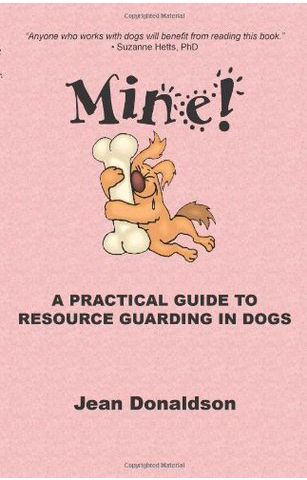
Mine!: A Practical Guide to Resource Guarding in Dogs
by Jean Donaldson
Jean Donaldson is a certified dog trainer and behavior consultant and an instructor at the Academy for Dog Trainers.
“The sad objective of these trainers seems to be to reach the end of the dog’s life having dispensed as few rewards as possible. It’s difficult to explain why an animal trainer would strive to be as stingy as possible, give the evidence of how powerful and safe positive reinforcement is. Maybe it’s psychological.” – Jean Donaldson
More excellent books to choose:
- Barking: The Sound of a Language by Turid Rugaas
- How Dogs Learn by Mary R. Burch and Bob Bailey
- How to Behave So Your Dog Behaves by Sophia Yin
- Inside of a Dog: What Dogs See, Smell and Know by Alexandra Horowitz
- My Dog Pulls. What Do I Do? by Turid Rugaas
- The Power of Positive Dog Training by Pat Miller
- The Cautious Canine: How to Help Dogs Conquer their Fears by Patricia McConnell
- The Puppy Whisperer: A Compassionate, Nonviolent Guide to Early Training and Care by Paul Owens and Terence Cranendonk
- The Puppy Primer by Patricia McConnell, Ph.D.
- A Kids’ Comprehensive Guide to Speaking Dog!: A fun, interactive, educational resource to help the whole family understand canine communication by Niki Tudge
- Feeling Outnumbered?: How to Manage and Enjoy your Multi-Dog Household by Karen B. London, Ph.D.
- Feisty Fido: Help for the Leash Aggressive Dog by Patricia McConnell
- Be Right Back!: How To Overcome Your Dog’s Separation Anxiety And Regain Your Freedom by Julie Naismith
- I’ll Be Right Back: How to Prevent and Treat Separation Anxiety by Patricia McConnell
- The Midnight Dog Walkers: Positive Training and Practical Advice for Living with Reactive and Aggressive Dogs by Annie Phenix
- Control Unleashed books by Leslie McDevitt
(Disclaimer: I received a complimentary advanced reader copy of “Enlightened Dog Training” through NetGalley. Opinions expressed in this review are completely my own.)
